Picture this: You have an unrivaled passion for your ecommerce business that sells useful, high-quality products—but your conversions are suffering. Could it have something to do with flat product descriptions?
We think so.
That’s why we’re writing this article, to show you how to inject passion and strategy into your product descriptions so they make the sales your business deserves.
Look at the above paragraphs as a product description for this article. An effective product description makes an impression and shows the customer how their lives will improve with your product.
At Boldist, we believe ecommerce business owners are pioneers of the modern internet. You provide the world with its most-needed products on the most convenient platform.
With all that potential, you need to outfit your products with product descriptions that get customers to the checkout page.
What Is a Product Description?
If a product is the inside of a house, the product description is the doormat that welcomes guests—customers—inside. It’s usually a short paragraph or bullets describing a product online.
Of course, product descriptions or product summaries have more power to draw people in or drive them away than a doormat. They’re the first impression of what the experience will be like with your product.
A good product description achieves the following:
- Provides crucial product information
- Anticipates and answers the customer’s questions
- Provides the most relevant features and benefits
- Helps the customer decide if the product is for them
- Persuades potential customers to buy
- Increases your product’s visibility on search engines and ecommerce platforms
So, how do you write product copy that sell your goods like hot cakes (and they very well could be hot cakes)?
Check out the steps below—paired with examples of product descriptions—to get you on your way.
8 Steps to Write Impressive Product Descriptions
1. Know Your Customer (Better Than Yourself)
The most effective salespeople know their customers inside and out—sometimes to a scary degree.
Product descriptions are like online sales representatives. As an ecommerce business, your website needs to flaunt product descriptions that sound like they’re speaking directly to your customers’ innermost desires and concerns.
That means building a buyer persona: a written representation of your ideal customer.
To create a buyer persona, gather customer data with customer relationship management tools, Facebook Insights, surveys, focus groups, and reviews.
Next, study your customers’ demographics, motivations, goals, interests, and concerns. You’ll start recognizing patterns to include in your buyer persona and make use of in your product descriptions.
Why’s This Important?
Your buyer persona is a guide to who the ideal customer is and how they behave, so use it to guide the language and content of your product descriptions. People respond well to product description writing that answers the questions in their heads, leading to more sales for your business.
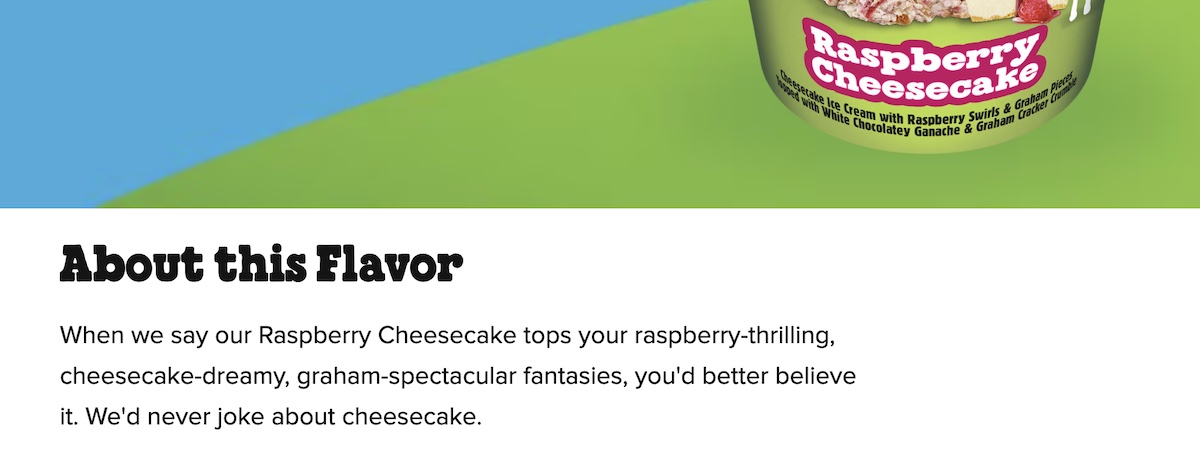
Product Description Example: This product description sample for Ben & Jerry’s Raspberry Cheesecake ice cream is brief (about 40 words total), humorous (“We’d never joke about cheesecake.”), and speaks directly to customers who like fun and often silly flavors (“raspberry-thrilling, cheesecake-dreamy, graham-spectacular”).
The ice cream company knows its audience and gets right to the point with engaging language.
When writing a description of your product, ask yourself why the customer needs this product.
2. Show Them the Benefits
After you have a good grip on your target audience, it’s time to list out the features and benefits of your product.
Features vs. Benefits
A product feature is an objective characteristic of your product. It’s the equivalent of features you’d use to describe yourself, such as age, eye color, and height.
But humans aren’t products, so we’re talking about product color, size, device compatibility, available settings, functions, parts, etc.
On the other hand, benefits show how the product can improve the customer’s life. Writing about product benefits is more subjective, but you know better than anyone how your product measurably meets your customers’ desires and needs.
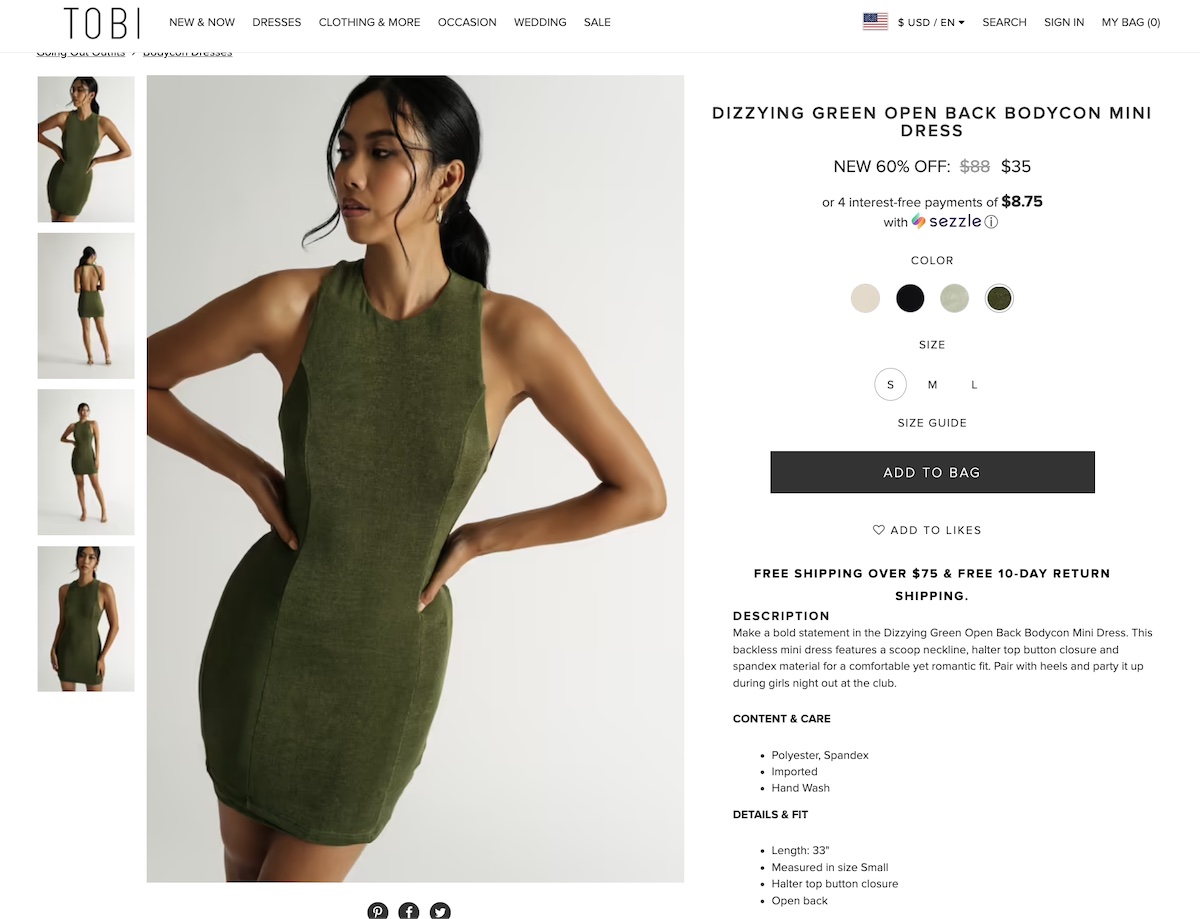
Product Description Example: This romper from TOBI shows the features and benefits in a way that describes the product and hits on why the customer would love it. Below, we’ve bolded the benefits and italicized the features in this item’s description to give you a better idea of what to aim for.
Make a bold statement in the Dizzying Green Open Back Bodycon Mini Dress. This backless mini dress features a scoop neckline, halter top button closure and spandex material for a comfortable yet romantic fit. Pair with heels and party it up during girls night out at the club.
Although your product likely has many features, only include those your customer would care about. Each feature you list should have a benefit—a “why you should care” description that helps the customer imagine what it’s like to have and use the product.
So, how do you get the customer to desire and imagine using your product?
You create emotion.
3. Build an Emotional Connection
Salespeople are successful because they create a relationship with their customers. Product descriptions aren’t too different.
Creating an emotional connection through product description copywriting is difficult because you can’t directly answer the customer’s questions, nor can you see their faces when they read (if you could, that’d be creepy).
But by now, you know your product and audience well enough to anticipate and address your customers’ concerns and desires.
Build a relationship with customers who come across your product by writing with empathy. Ask the question: Why is the customer looking for this product?
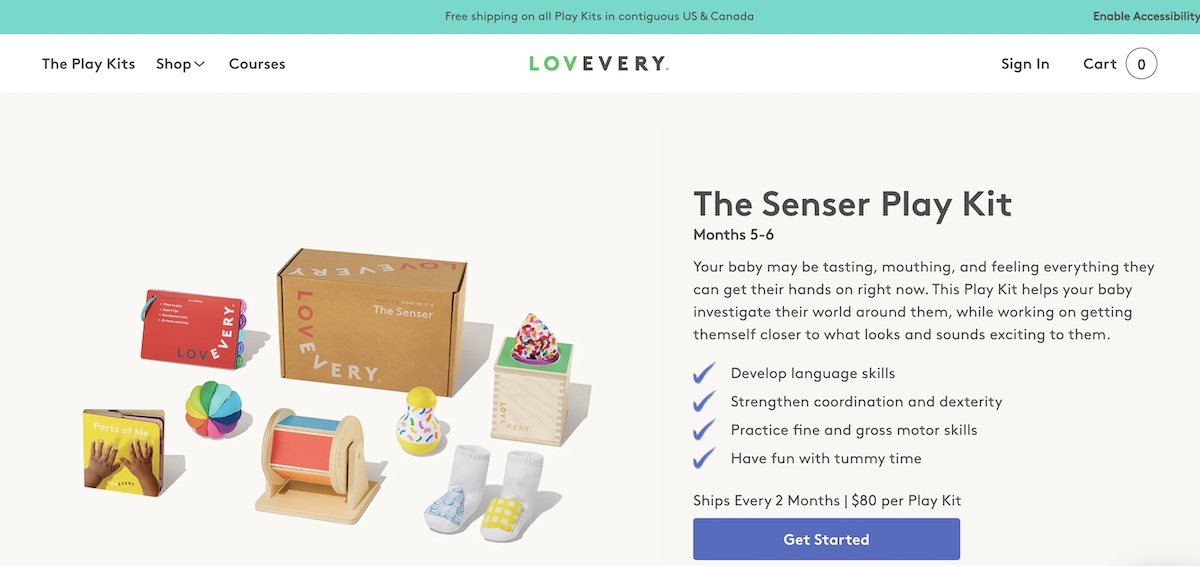
Product Description Example: This Play Kit from Lovevery touches on an emotional and developmental journey for babies.
Notice how the product description claims that babies who use the Play Kit can “investigate their world around them” and get “closer to what looks and sounds exciting to them.” There’s a story in this description about wonderment and curiosity.
Beneath the “Get Started” button is a wealth of baby-related features and benefits that come with the Play Kit. The language Lovevery uses to describe the benefits is relatable and in line with the language of parents with small children.
Building an emotional connection is easier when you choose the right words to make the customer feel like your best bud—or at least a close work friend.
4. Write Genuinely
Sometimes, genuine words are all it takes to build a relationship with someone.
When writing product descriptions, substitute fluffy, unmemorable adjectives for natural language that fits your brand’s voice. Energize your customers without overdoing it.
Good Practices to Stay Genuine
When writing your product description, imagine the customer is right in front of you or that they are a friend you believe should try the product. How would you describe a product to them in person?
You can also read your description out loud to see if it flows conversationally and engagingly. Use the second-person perspective (“you,” “yours”) to be more personal.
If you struggle to develop lively language for your product description, you can reference this list of over 800 “power words” that pull customers in.
Stay genuine by using these adjectives sparingly and only when they truly fit the meaning you want to convey.
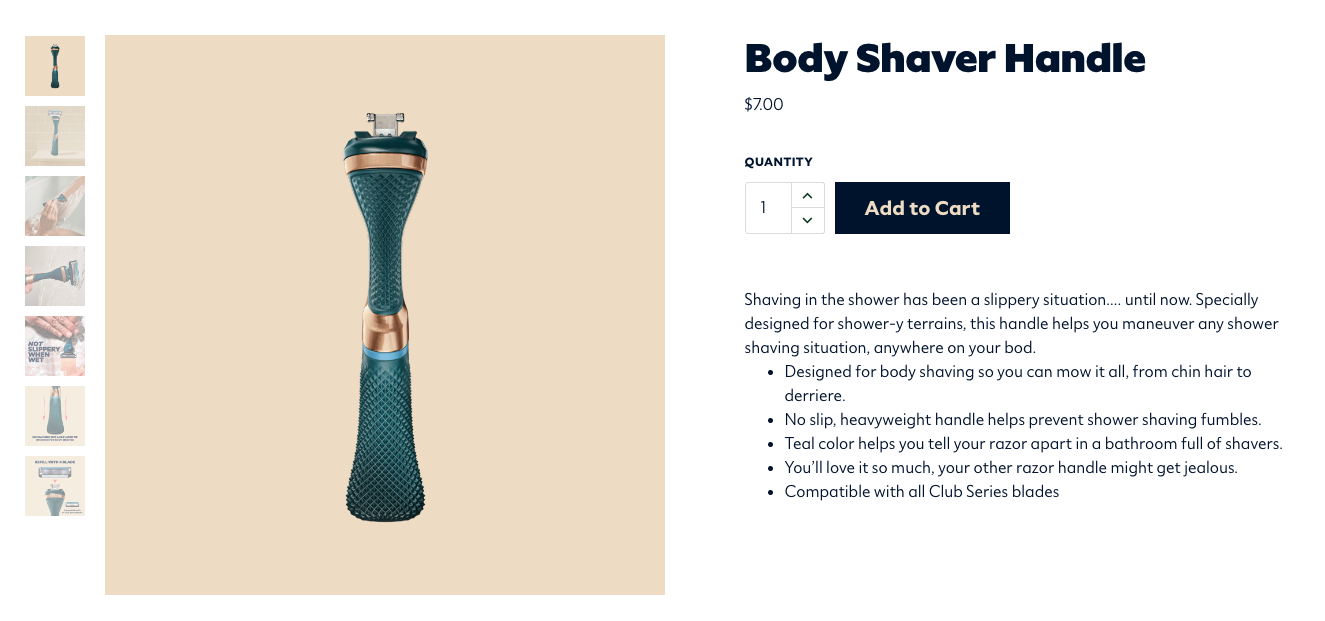
Product Description Example: The description for this shaver handle from Dollar Shave Club uses abbreviated language (“bod”), second-person perspective (“your”), and some light humor (“slippery situation”).
These characteristics show the customer that Dollar Shave Club understands their needs and is an approachable company.
And just as you wouldn’t tell a new friend your entire life story within a minute of meeting them, it’s best to keep your product description brief. We’ll cover that next.
5. Facilitate Readability and Scannability
If you want to engage potential customers with your product descriptions, they have to be scannable. We know you have loads of information you want to share about your product, but customers only want the things they care about.
In fact, when reading online, 81% of people scan instead of fully read. That doesn’t give blocks of text much of a chance to describe how cool your product is.
Make it easier to digest your product overview with the following:
- Short paragraphs
- White space
- Bullets
- Different font sizes and colors to divide sections
- Imagery (e.g., product photos, icons, diagrams)
- Product videos
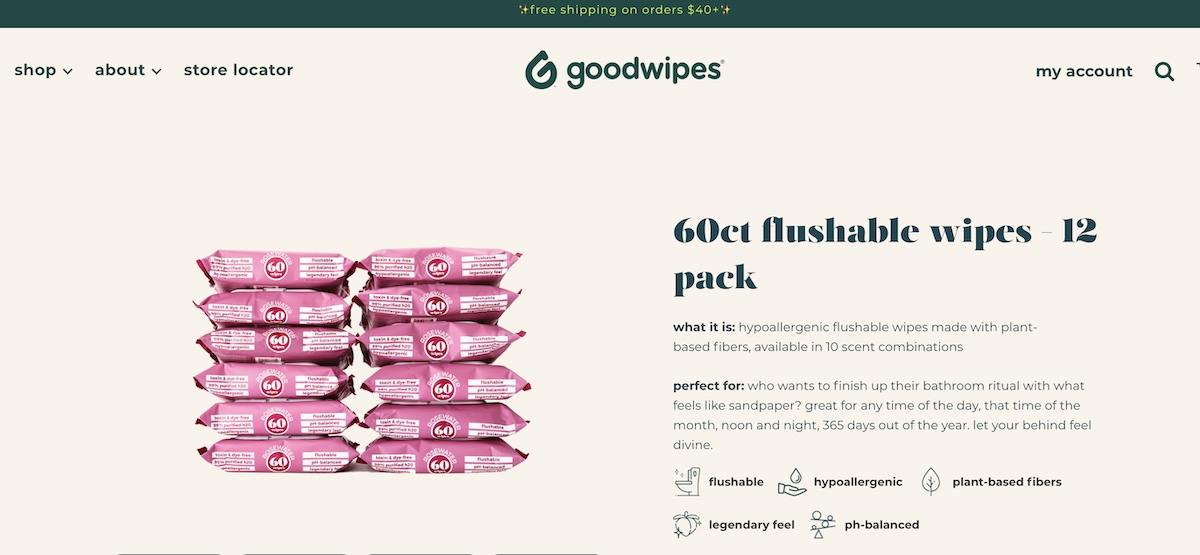
Product Description Example: This product overview for flushable wipes from Goodwipes uses bolded fonts, short paragraphs, and icons to make skimming easy. In this short product description example, you quickly get a feel for what the product is, its features, and its benefits.
But while you have to keep things short, make sure you still keep them sweet—for people as well as search engines.
6. Keep Search Engine Optimization (SEO) in Mind
SEO for product descriptions is a lot about using keywords to help search engines like Google recognize your content and make it more visible to users.

Product Description Example: If a user looks up the keyword “ripped jeans,” ROMWE’s product description page for “Light Washed Cut Out Ripped Straight Leg Jeans” pops up partly because the product title contains the keyword.
You want customers looking for products like yours to find your product description. After all, customers won’t buy a product they can’t find.
Use Google to see what results come up for a keyword or use research tools like Ahrefs to find associated keywords.
You should also strategically use your keywords instead of throwing them randomly throughout your product description. Include keywords naturally and where it helps consumers find your product.
Optimize your product’s page by using keywords in:
Creative product descriptions combine keywords with eye-catching language to create an online shopping experience that is equally engaging and functional.
A Note on SEO
Including keywords in the text associated with your product doesn’t guarantee that customers will immediately find it. But SEO is a good way to increase the likelihood of your product appearing in search results, and it is imperative if you want a fighting chance against your competitors.
7. Give Proof People Actually Like Your Pudding (Product)
Chances are, you have several happy customers already. If you don’t, well, you might have a problem with your business model (or you’re very, very new).
Using social proof in your product descriptions instantly adds credibility to your brand and product.
Social proof puts people at ease about your product because it’s evidence that a real person (not just the company) likes it.
Social proof can look like the following:
- Product reviews
- Testimonials
- Ratings
- Social media posts featuring your product
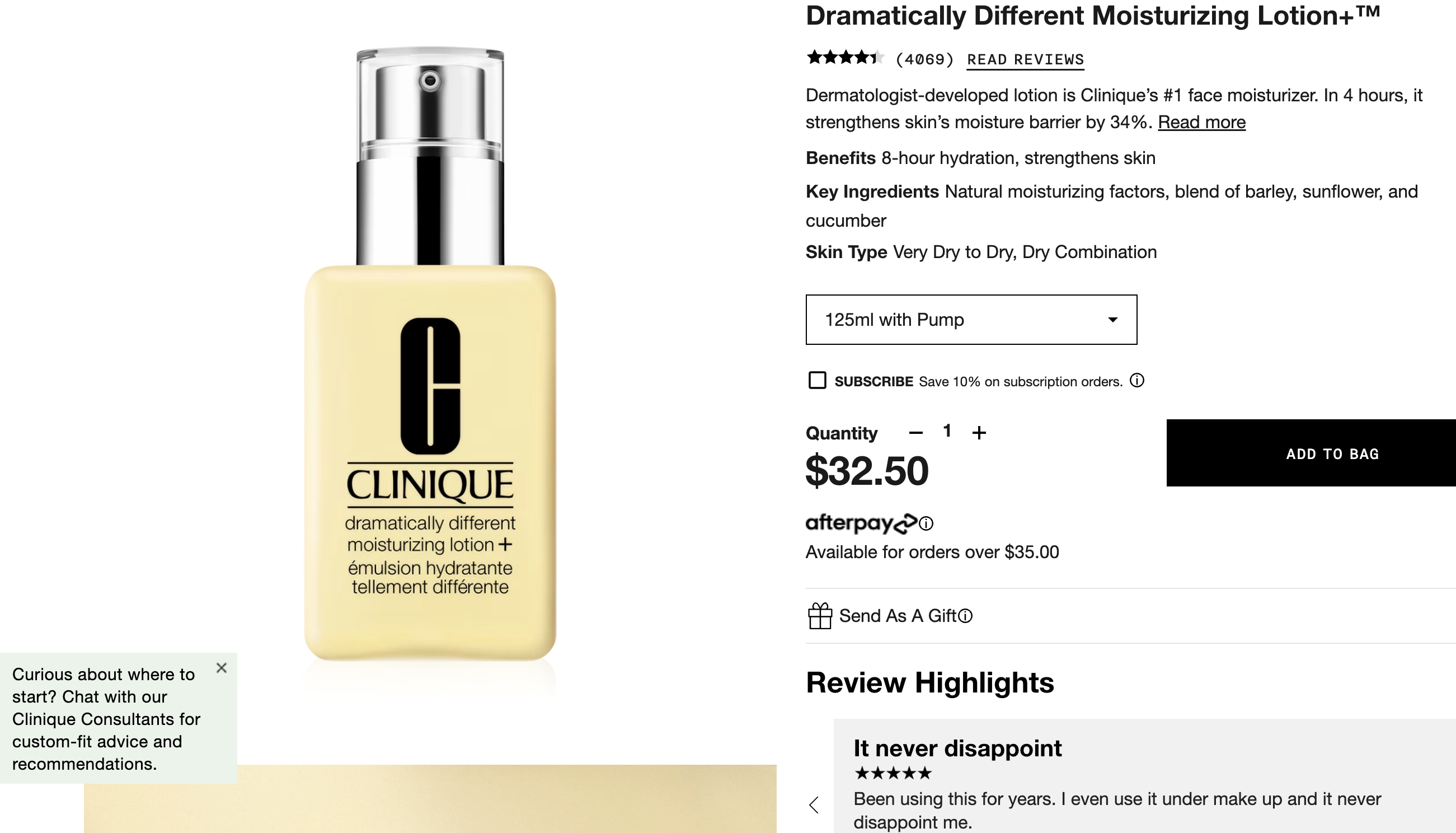
Product Description Example: Clinique uses a star rating just below its product title and a review carousel under the price to convince customers that the lotion is well-liked.
8. Make Your Own Product Description Template
After you create a stellar product description, you might be wondering, How can I do this again and again? It helps to make a template.
To get your juices flowing, keep the following items in mind:
- Introduce the product with a headline that catches shoppers’ attention.
- Briefly set up the problem and how your product solves it.
- List your product’s features, technical details, and benefits.
- Add an element of social proof.
- Conclude with a call to action.
Besides that, you know your brand voice best and what information your audience needs to make a purchase.
For example, for ecommerce clothing businesses, you may need your template to include information about the size of the model in the photo and whether the item runs true to its size.
Because product categories range, it’s better to develop your own product summary template that works for your ecommerce business and product types.
How Do I Know If My Product Descriptions Are Working?
To know if your new product descriptions are working to increase sales, set specific, measurable goals. Use key performance indicators (KPIs) as measurements to monitor if your product description has resulted in more conversions.
Possible KPIs to measure success include:
- Organic search rankings
- Conversion rate
- Support inquiries
- Return rate
- Cart abandonment rate
- Bounce rate
- Clickthrough rate
You can also use an A/B testing service to compare the sales of two descriptions to determine the best product description based on performance.
Don’t Downplay the Description
Product descriptions can make or break an online sale. As an ecommerce business owner in today’s age, online shoppers won’t give you the time of day unless you do everything in your power to catch their attention.
Now you know how to craft an ecommerce product description that will stop the bounce and gain loyal clicks from your customers.
Above all, remember your audience and how they can enjoy your product the way you do.


